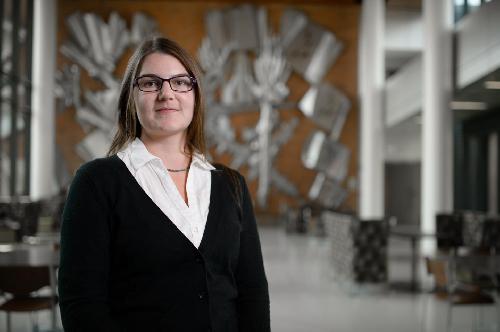EAST LANSING, Mich. - Scientists chase unicorns because if they could prove the existence of the magical beasts, the world would be a better place.
Take Maren Friesen, Michigan State University plant biologist, for example. Her quest was to find near-mythical bacteria that could fix their own nitrogen. Her search for such magical beasties was based on results from Germany published in the 1990s that seemed to confirm their existence.
The end result, published in the current issue of Nature's Scientific Reports, proved that the elusive bacteria, Streptomyces thermoautotrophicus, did in fact exist but didn't have any mythical qualities.
 MSU plant biologist Maren Friesen asks: Why do scientists chase unicorns? Credit: G.L. Kohuth
MSU plant biologist Maren Friesen asks: Why do scientists chase unicorns? Credit: G.L. Kohuth
Most nitrogen-fixing bacteria use an enzyme that does not work when oxygen is present. The heat and toxic gas-loving strain that Friesen studied appeared to have exceptional properties, including harboring a special enzyme that was insensitive to oxygen. So why go on such a quest?
"If they actually existed, it would mean we could have plants that could fix their own nitrogen, a compound used in critical biological functions, with no need for nitrogen fertilizers," said Friesen. "In this dream world, there would be less pollution, less nitrogen runoff into rivers and streams, less greenhouse gas emissions, less fuel being used to transport and apply fertilizer."
That is a unicorn worth chasing, she added.
So why is it worth proving that it's a myth, that it doesn't exist?
While Friesen and an international team of scientists remained highly skeptical of the bacteria's existence, the positive result in the literature had long tantalized researchers. However, there were no other papers from independent labs to confirm the original findings.
"This outlying result was always there, always lingering in published papers," Friesen said. "Now we've been able to bury this once and for all."
The myth began in Germany, where the bacteria were discovered, and their mythical properties were suggested. They thrived in the hot, toxic fumes over traditional charcoal fires where large quantities of wood were buried and burnt down.
Friesen's collaborators traveled to Germany and gathered samples while she went to Centralia, Pa., where underground coal fires have been burning for decades. She was somewhat surprised that she was able to find the bacteria, lending a bit of credence to the myth.
The tale grew even more when they produced a positive result in the laboratory, demonstrating that the bacteria did indeed fix their own nitrogen. This, however, turned out to be a tainted result.
"We learned that the gas that everyone had been using for the experiments was contaminated," Friesen said. "For the next experiments, we had to introduce a number of new controls, which included washing or purifying the gas we used."
Dispelling the myth turned out to be a roller coaster of results and reactions - from actually finding the missing bacteria to a positive result that bolstered the tall tale, and from conducting many, many more experiments to finally killing the bacterial unicorn.
While one mythical notion died, the concept of international collaboration and open data grew. Scientists from Harvard University, Imperial College (London), Aachen University (Germany) and Universidad Nacional de Rosario, Zavalla (Argentina) contributed to key aspects of the research. Rather than focus on one experiment, the team conducted many experiments around the world.
"By sharing data, you can have a lot of influence," Friesen said. "The most-influential datasets are the ones that everyone is using. And as this research demonstrated, it's better to compare your results to other researcher's data than believe a singular result. Reproducibility is really key to good science."
Even if it means a few unicorns must die.
source: Michigan State University